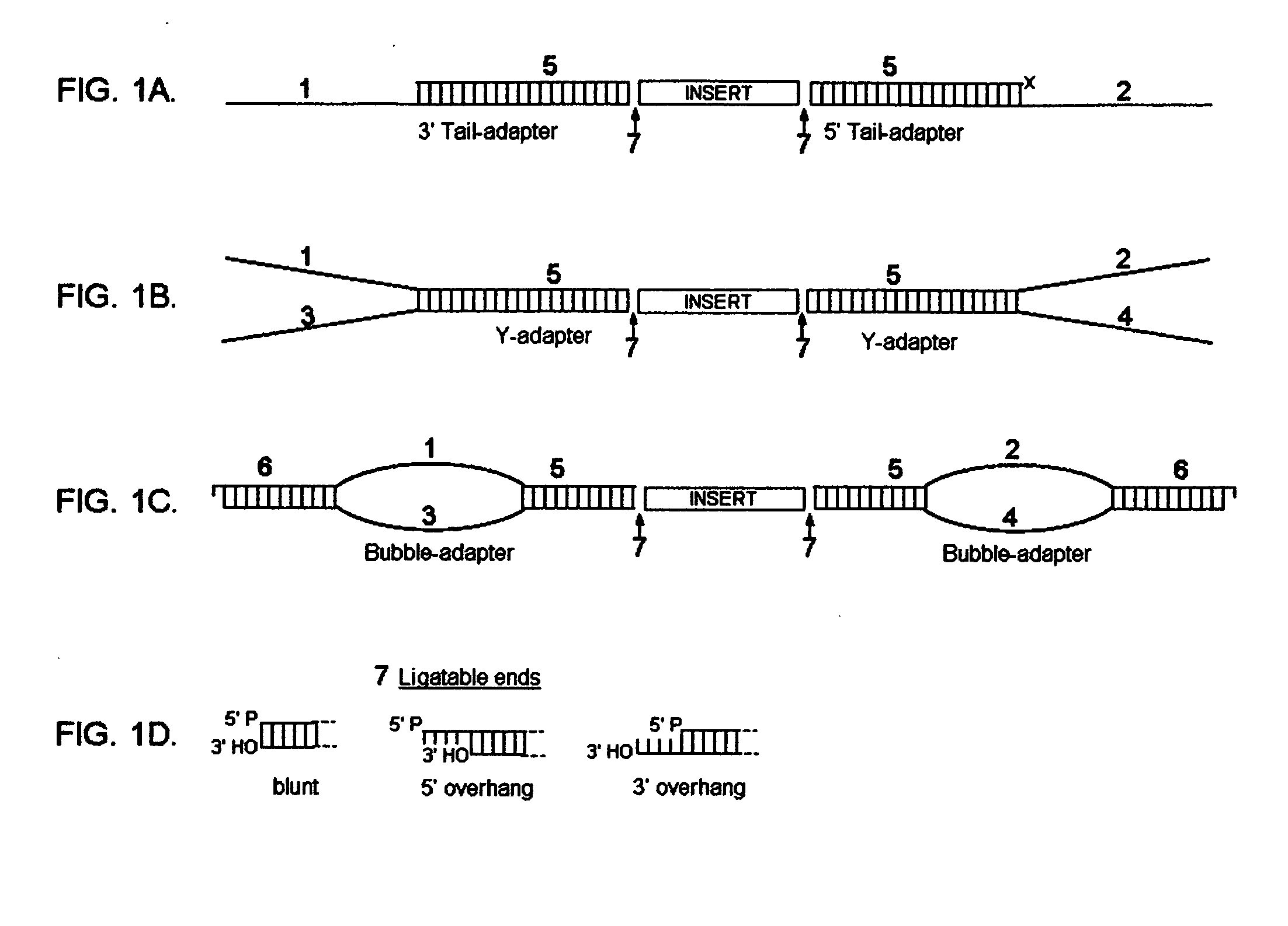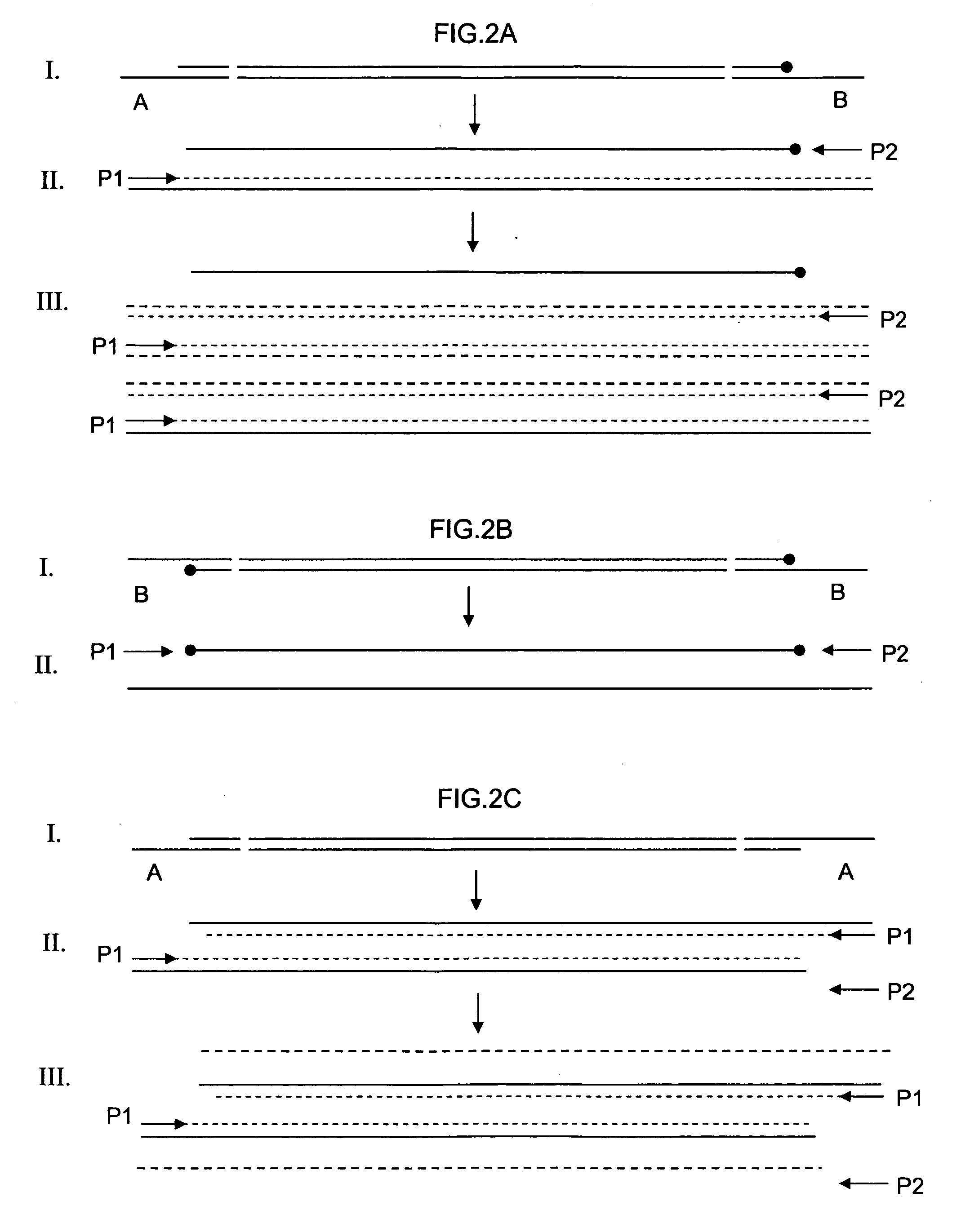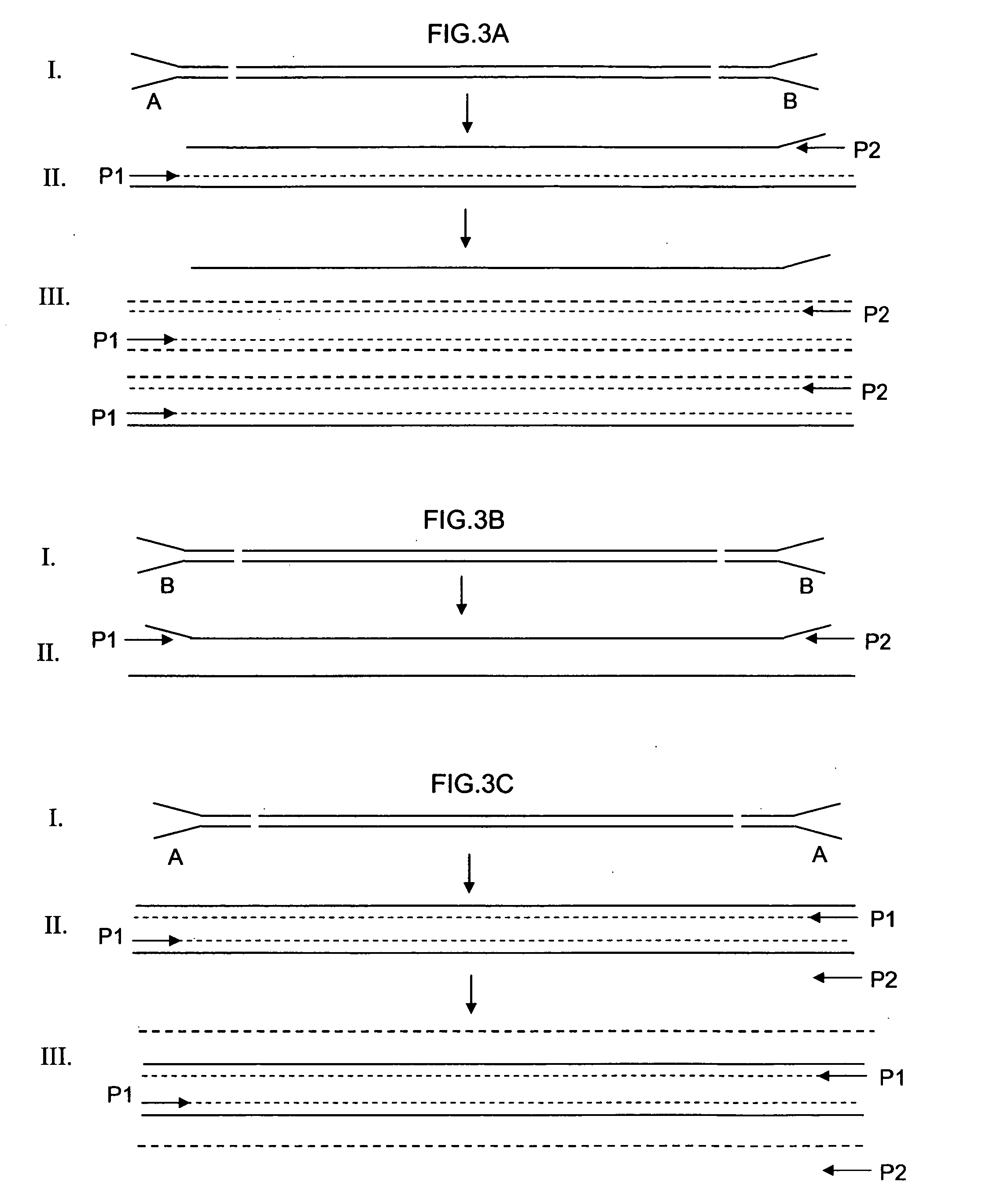Asymmetrical adapters and methods of use thereof
- Summary
- Abstract
- Description
- Claims
- Application Information
AI Technical Summary
Benefits of technology
Problems solved by technology
Method used
Image
Examples
example 1
ASYMMETRICAL ADAPTERS
[0203] In FIGS. 1A-C, the novel adapters of the present invention are schematically represented. FIG. 1A is a schematic representation of a 3′ asymmetrical tail adapter and 5′ asymmetrical tail adapter, each having a double-stranded region (5) ligated to a DNA fragment (insert) via a ligatable end (7). The 3′ asymmetrical tail adapter has a 3′ overhang (1), and the 5′ asymmetrical tail adapter has a 5′ overhang (2). FIG. 1B is a schematic representation of two different asymmetrical Y adapters, each having a double-stranded region (5) ligated to a DNA fragment (insert) via a ligatable end (7). Each asymmetrical Y adapter has two unpaired strands (1,2,3,4), each of which has a different sequence. FIG. 1C is a schematic representation of two different asymmetrical bubble adapters, each having a double-stranded region (5) ligated to a DNA fragment (insert) via a ligatable end (7). Each asymmetrical bubble adapter has an unpaired region wherein the unpaired strands ...
example 2
PCR CONFIRMATION OF SELECTIVE AMPLIFICATION
[0209] Several ligations and coupled ligation / PCR reactions were performed using asymmetric tail adapters selected from the following.
AsymA1:(SEQ ID NO:15)5′pCTGTCGTCTTGCAsymA2:(SEQ ID NO:16)5′pGCAAGACGAGAGGTCCCACACGTAACACCAAACCTATCCACACTTTTACAAACCACTAGGACAGTCGCTACCTTAGTGAsymA3:(SEQ ID NO:17)5′pGCAAGACGAGAGGTCCCACACGTAACACTAGGACAGTCGCTACCTTAGTGAsymA4:(SEQ ID NO:18)5′GTGTTACGTGTGGGACCTCTCGTCTTGGAsymB1:(SEQ ID NO:19)5′-pCATCGTAC*T*C*T*ddCddCddCAsymB2:(SEQ ID NO:20)5′CCTTAGGACCGTTATAGTTAGGTGCAGAAGCGAACACAGAGAGTAGGATGAsymB3:(SEQ ID NO:21)5′CCTTAGGACCGTTATAGTTAGGTGGAGAGTAGGATGAsymB4:(SEQ ID NO:22)5′pCATCCTACTCTCTGTGTTCG*C*T*T*ddCddCddC
[0210] Adapter A corresponds to a hybridization of AsymA2 and AsymA4 to form an asymmetrical tail adapter (adapter A); adapter A2 corresponds to a hybridization of AsymA3 and AsymA4 to form an asymmetrical tail adapter (adapter A2); and adapter B corresponds to a hybridization of AsymB1 and AsymB3 to form an asym...
example 3
CONSTRUCTION OF A PAIRED END LIBRARY FROM E. COLI STRAIN DH10B USING MmeI OR EcoP15I ADAPTERS
[0212] This example utilizes the strategy shown schematically in FIG. 6 to construct a representative library of amplified genomic DNA fragments with asymmetric adapters derived form the E. coli DH10B genome.
[0213] Ten miocrograms of genomic DNA from E. coli strain DH10b was randomly sheared on a Hydroshear machine, in a volume of 120 ul using shear Code 12 for 20 cyles. 60 ug of the sheared DNA was fractionated on a 1.2% TAE-Agarose gel and DNA fragments in a 1.8-4 kb size range were collected (Results shown in FIG. 7A).
[0214] The DNA fragments were extracted from gel using a Qbiogene GeneClean kit. 13.6 ug of sheared, sized selected DNA was recovered. The fragments were blunt-ended using a mixture of T4 DNA Polymerase, T4 Polynucleotide Kinase, dATP, dCTP, dGTP. dTTP and ATP (Epicentre ‘Endit’ Kit) under the following conditions:
[0215] 136 ul sheared, sized selected DNA
[0216] 20 ul End...
PUM
| Property | Measurement | Unit |
|---|---|---|
| Temperature | aaaaa | aaaaa |
| Temperature | aaaaa | aaaaa |
| Angle | aaaaa | aaaaa |
Abstract
Description
Claims
Application Information
 Login to View More
Login to View More - R&D
- Intellectual Property
- Life Sciences
- Materials
- Tech Scout
- Unparalleled Data Quality
- Higher Quality Content
- 60% Fewer Hallucinations
Browse by: Latest US Patents, China's latest patents, Technical Efficacy Thesaurus, Application Domain, Technology Topic, Popular Technical Reports.
© 2025 PatSnap. All rights reserved.Legal|Privacy policy|Modern Slavery Act Transparency Statement|Sitemap|About US| Contact US: help@patsnap.com



